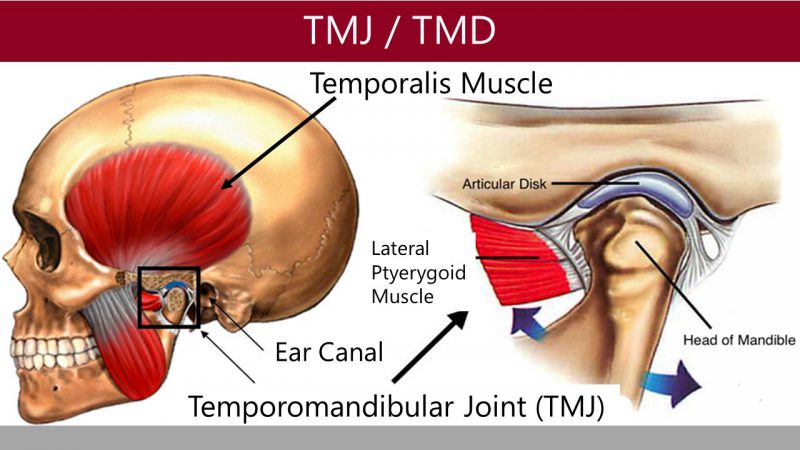What is your TMJ?
TMJ stands for – temporomandibular joint.
Your temporomandibular joint connects the mandible (jaw bone) to the temporal bone, with an articular disc separating both.
It is a hinge joint that facilitates the opening and closing of the move, in addition to protrusion and retrusion (moving the jaw forwards and backwards) and lateral side to side movement of the jaw.
Your TMJ is an anchor for four key muscles. These muscles can be noticeably felt by putting your index finger in your ear, whilst moving your jaw through ranges of motion.

The temporomandibular joint is the most frequently used joint in the body, it is used to speak, chew, swallow and yawn.
Being such a constantly used joint, it is estimated that 85-90% of the population will experience some problem or discomfort during their lifetime.
TMJ disorders and syndrome
TMJ syndrome can present with many symptoms and complaints.
These can vary from a classic presentation of jaw pain, problems with chewing, difficulty opening and closing the mouth, clicking and grinding in the jaw, to more uncommon symptoms such as headaches and earaches.

What are the causes of TMJ disorders
Between your temporal and mandibular bones is an articular disc that allows normal movement of the TMJ to occur.
When there are changes to the position and structure of this disc and it’s articulating bones and muscles, TMJ disorders can arise.
For instance, a common TMJ disorder symptom of ‘clicking’, occurs when the mandibular condyle does not correctly move in correlation to the disc.
Common causes of TMJ disorders can result from trauma to the face, excessive or abnormal chewing, and high levels of stress and anxiety.

Traditional treatment for TMJ disorders vs Chiropractic for TMJ disorders
Common medical treatments for TMJ related pain and discomfort include paracetamol and oral appliances.
These interventions focus on and provide short term relief of symptoms.
A chiropractic approach differs significantly.
Our aim is to improve the structure of the joint to improve its function.
When a temporomandibular joint is functioning without correctly without irritation, that surrounding structures (muscles and neurology) work as intended – with no discomfort.
The approach used by a chiropractor to assess and address TMJ disorders differs depending on the specific presentation of the patient.
Commonly, the approach will involve gentle hands on manipulation of the mandible and its articulating disc back to a more normal position.

Frequently this affords short term relief. However, as chiropractors, our focus is not just improving the symptoms, but addressing the underlying cause.
Because of this, it is important to assess the relationship between the TMJ and the upper cervical spine- in addition to its surrounding structures.
It is common for there to be a conjoint relationship between these two regions, and as a result, our focus will broaden to this region also.
Research
Chiropractic care has been highlighted within the literature to be an incredibly safe and effective approach to addressing TMJ disorders(1)(2)(3).
One study demonstrated such improvements in patients with TMJ disorder(1) by aiming to restore balance to the TMJ.
Chiropractic was shown to remove and minimise the adverse effects of unequal load distribution on the joint, in effect improving function, motion, and the reduction/elimination of pain(1).

Another study(4) found that the causes of TMJ complaints are believed to be multi-factorial and include postural alterations that can lead to hypo/hypertonic muscles and cervical spine restrictions, visceral insufficiency, and neuronal irritation.
In this study they utilised conservative chiropractic care, and found the patients symptoms were improved after three visits.
Rather than constantly repairing damage, at Sims & Finn Chiropractic Dandenong, our aim and focus is on addressing the underlying cause of your presenting complaint and to help you function correctly and to your optimal potential.
Our approach is not for everyone. However, if you are tired of constantly masking the symptoms and you are looking for a longer term solution that you can both feel and see for yourself, then our professional chiropractors at Sims & Finn Dandenong are more than happy to help.
To make an appointment, please either book online via our website, or call our friendly staff.
Sims & Finn Chiropractic
52 Stud Road, Dandenong 3175
References:
- Pavia, S., Fischer, R., & Roy, R. (2015). Chiropractic Treatment of Temporomandibular Dysfunction: A Retrospective Case Series. Journal of chiropractic medicine, 14(4), 279–284. doi:10.1016/j.jcm.2015.08.005
- Björne, Assar. (2007). Assessment of temporomandibular and cervical spine disorders in tinnitus patients. Progress in brain research. 166. 215-9. 10.1016/S0079-6123(07)66019-1.
- Devocht, James & Schaeffer, Wally & Lawrence, Dana. (2005). Chiropractic treatment of temporomandibular disorders using the activator adjusting instrument and protocol. Alternative therapies in health and medicine. 11. 70-3.
- Yuill, E., & Howitt, S. D. (2009). Temporomandibular joint: conservative care of TMJ dysfunction in a competitive swimmer. The Journal of the Canadian Chiropractic Association, 53(3), 165–172.

